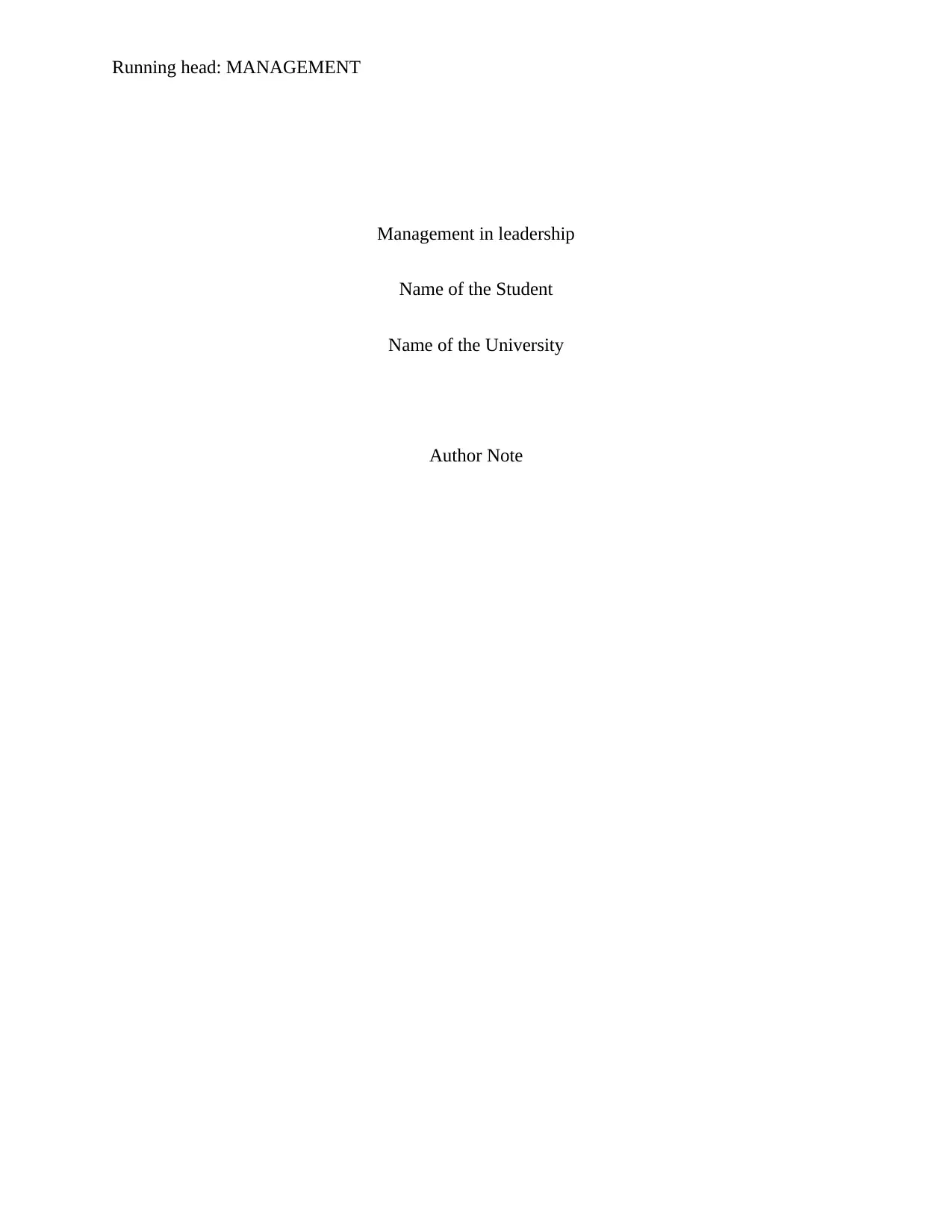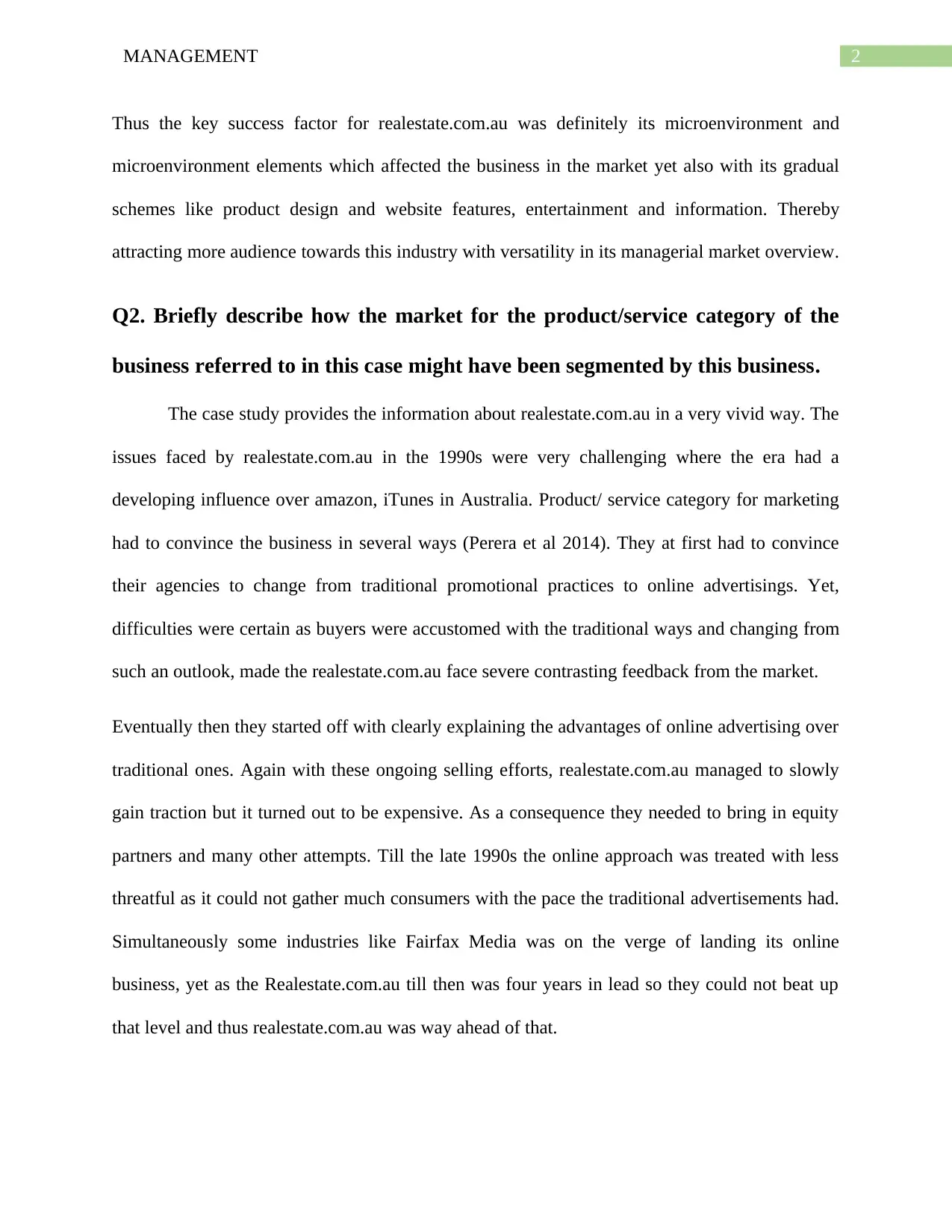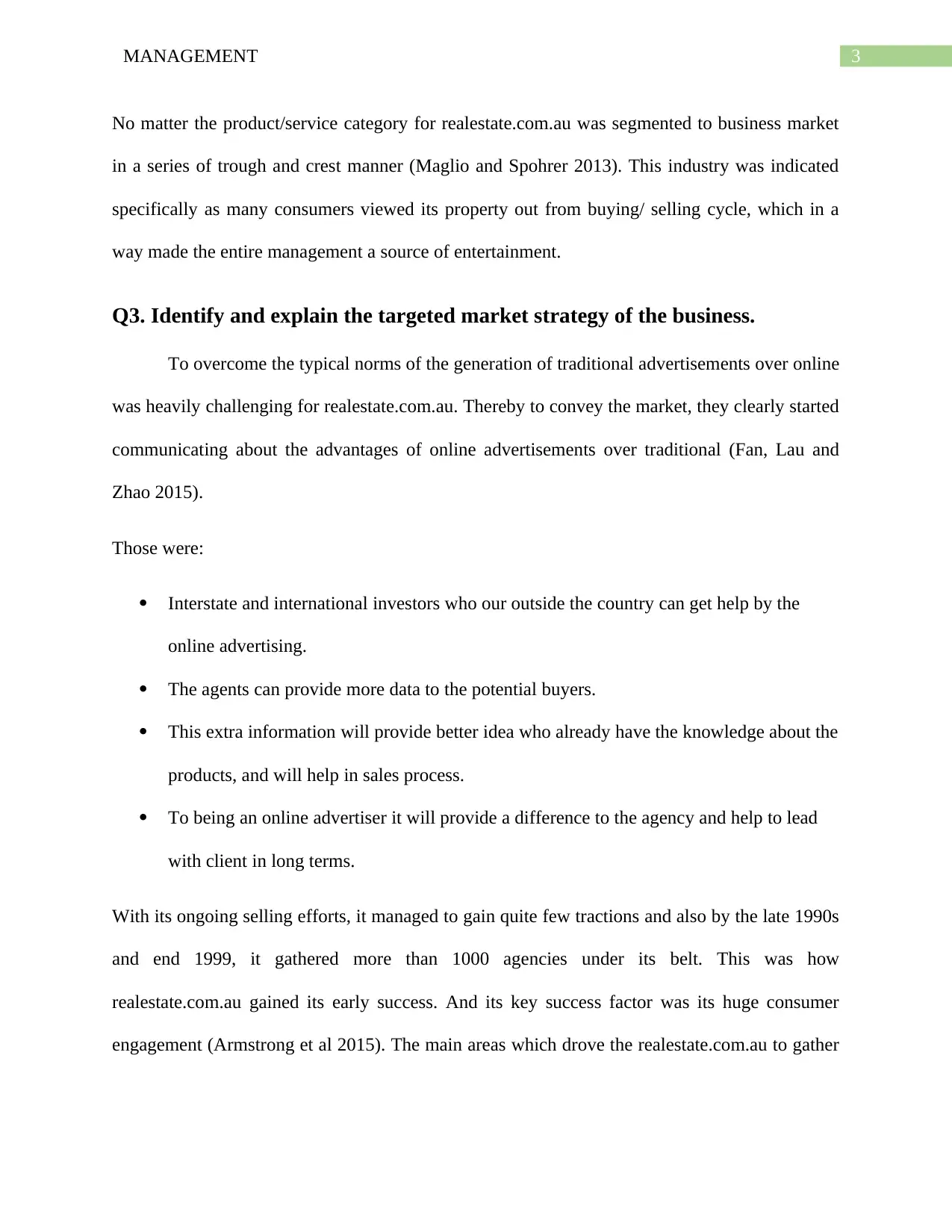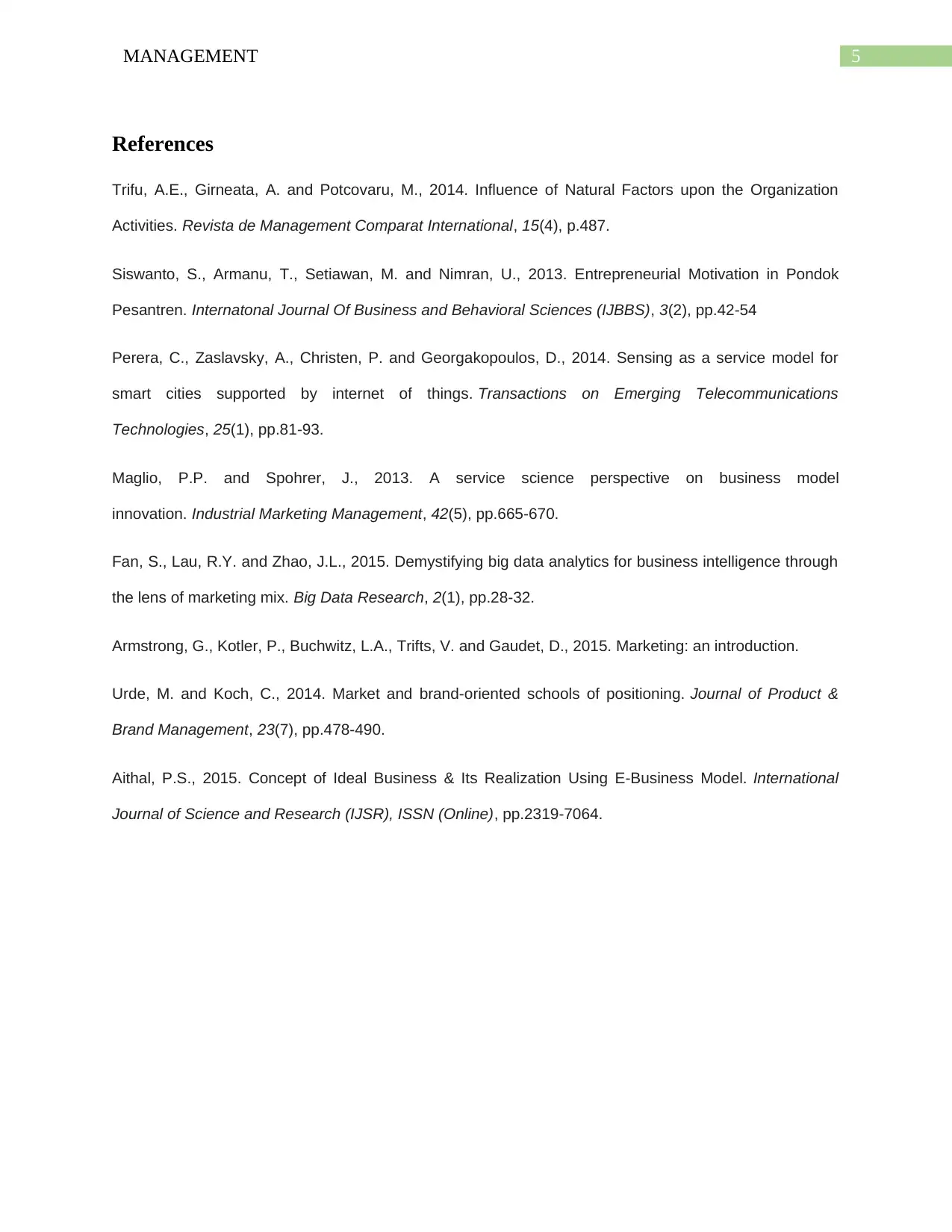Case Study: Analyzing Realestate.com.au's Market Strategy & Growth
VerifiedAdded on 2023/04/23
|6
|1456
|104
Case Study
AI Summary
This case study provides an analysis of Realestate.com.au's business strategies, focusing on its micro and macro environments, market segmentation, target market, and overall market positioning. The company's success in the late 1990s is attributed to its ability to leverage economic and technological macro forces by offering online advertising solutions to overcome the limitations of traditional media. Microenvironment elements such as customer engagement and competitive dynamics also played a crucial role. The company segmented its market by targeting real estate agencies and convincing them of the advantages of online advertising, despite initial resistance. Their targeted marketing strategy involved highlighting the benefits of online advertising, such as reaching interstate and international investors, providing more data to potential buyers, and differentiating agencies. Realestate.com.au's positioning evolved from being an information tool to a source of entertainment, which they reinforced through engaging content and lifestyle sections, eventually leading to market revenue and penetration.

Running head: MANAGEMENT
Management in leadership
Name of the Student
Name of the University
Author Note
Management in leadership
Name of the Student
Name of the University
Author Note
Paraphrase This Document
Need a fresh take? Get an instant paraphrase of this document with our AI Paraphraser

1MANAGEMENT
Q1. Justify and discuss the selection of two key microenvironment and two
key macroenvironment elements that are likely to affect the business referred
to in this case.
In the field of business, if it is categorized under microenvironments and macro
environments, the basic macro environments include six different forces. They are Demographic,
Economic, Political, Ecological, Socio cultural and technological forces. Again similarly the
microenvironment factors include customers, staff, competitors, media, shareholders, and dealers
(Trifu, Girneata and Potcovaru 2014).
From this case study about the realestate.com.au, we come across the success story of how this
industry managed to become a prevalent outlook in the late 1990s. Its main agenda was to
outrage the online advertising media over traditional ways. This was eventually achieved in a
bundle of successive years of tries. With its showcasing the audience and consumers with the
advantages to the backlash and eventually depicting its own success story over the others.
Citing about the key macro environments, it used economic and technological forces. Where
they were focused on how they could convey the message of the vital reason that people who
were outside the geographic reach of newspapers could avail the online facility such as interstate
and international investors. Thus these way agents could share information in more simple ways
through photographs and floor plans (Siswanto et al 2013).
Similarly, the microenvironment elements which provoked the growth of this industry, were
prospectus of knowledgeable information about the new approach in more efficient sales
process. This was eventually a key factor which pushed to gather more engagements with
consumer, market, clients and competitors.
Q1. Justify and discuss the selection of two key microenvironment and two
key macroenvironment elements that are likely to affect the business referred
to in this case.
In the field of business, if it is categorized under microenvironments and macro
environments, the basic macro environments include six different forces. They are Demographic,
Economic, Political, Ecological, Socio cultural and technological forces. Again similarly the
microenvironment factors include customers, staff, competitors, media, shareholders, and dealers
(Trifu, Girneata and Potcovaru 2014).
From this case study about the realestate.com.au, we come across the success story of how this
industry managed to become a prevalent outlook in the late 1990s. Its main agenda was to
outrage the online advertising media over traditional ways. This was eventually achieved in a
bundle of successive years of tries. With its showcasing the audience and consumers with the
advantages to the backlash and eventually depicting its own success story over the others.
Citing about the key macro environments, it used economic and technological forces. Where
they were focused on how they could convey the message of the vital reason that people who
were outside the geographic reach of newspapers could avail the online facility such as interstate
and international investors. Thus these way agents could share information in more simple ways
through photographs and floor plans (Siswanto et al 2013).
Similarly, the microenvironment elements which provoked the growth of this industry, were
prospectus of knowledgeable information about the new approach in more efficient sales
process. This was eventually a key factor which pushed to gather more engagements with
consumer, market, clients and competitors.

2MANAGEMENT
Thus the key success factor for realestate.com.au was definitely its microenvironment and
microenvironment elements which affected the business in the market yet also with its gradual
schemes like product design and website features, entertainment and information. Thereby
attracting more audience towards this industry with versatility in its managerial market overview.
Q2. Briefly describe how the market for the product/service category of the
business referred to in this case might have been segmented by this business.
The case study provides the information about realestate.com.au in a very vivid way. The
issues faced by realestate.com.au in the 1990s were very challenging where the era had a
developing influence over amazon, iTunes in Australia. Product/ service category for marketing
had to convince the business in several ways (Perera et al 2014). They at first had to convince
their agencies to change from traditional promotional practices to online advertisings. Yet,
difficulties were certain as buyers were accustomed with the traditional ways and changing from
such an outlook, made the realestate.com.au face severe contrasting feedback from the market.
Eventually then they started off with clearly explaining the advantages of online advertising over
traditional ones. Again with these ongoing selling efforts, realestate.com.au managed to slowly
gain traction but it turned out to be expensive. As a consequence they needed to bring in equity
partners and many other attempts. Till the late 1990s the online approach was treated with less
threatful as it could not gather much consumers with the pace the traditional advertisements had.
Simultaneously some industries like Fairfax Media was on the verge of landing its online
business, yet as the Realestate.com.au till then was four years in lead so they could not beat up
that level and thus realestate.com.au was way ahead of that.
Thus the key success factor for realestate.com.au was definitely its microenvironment and
microenvironment elements which affected the business in the market yet also with its gradual
schemes like product design and website features, entertainment and information. Thereby
attracting more audience towards this industry with versatility in its managerial market overview.
Q2. Briefly describe how the market for the product/service category of the
business referred to in this case might have been segmented by this business.
The case study provides the information about realestate.com.au in a very vivid way. The
issues faced by realestate.com.au in the 1990s were very challenging where the era had a
developing influence over amazon, iTunes in Australia. Product/ service category for marketing
had to convince the business in several ways (Perera et al 2014). They at first had to convince
their agencies to change from traditional promotional practices to online advertisings. Yet,
difficulties were certain as buyers were accustomed with the traditional ways and changing from
such an outlook, made the realestate.com.au face severe contrasting feedback from the market.
Eventually then they started off with clearly explaining the advantages of online advertising over
traditional ones. Again with these ongoing selling efforts, realestate.com.au managed to slowly
gain traction but it turned out to be expensive. As a consequence they needed to bring in equity
partners and many other attempts. Till the late 1990s the online approach was treated with less
threatful as it could not gather much consumers with the pace the traditional advertisements had.
Simultaneously some industries like Fairfax Media was on the verge of landing its online
business, yet as the Realestate.com.au till then was four years in lead so they could not beat up
that level and thus realestate.com.au was way ahead of that.
⊘ This is a preview!⊘
Do you want full access?
Subscribe today to unlock all pages.

Trusted by 1+ million students worldwide

3MANAGEMENT
No matter the product/service category for realestate.com.au was segmented to business market
in a series of trough and crest manner (Maglio and Spohrer 2013). This industry was indicated
specifically as many consumers viewed its property out from buying/ selling cycle, which in a
way made the entire management a source of entertainment.
Q3. Identify and explain the targeted market strategy of the business.
To overcome the typical norms of the generation of traditional advertisements over online
was heavily challenging for realestate.com.au. Thereby to convey the market, they clearly started
communicating about the advantages of online advertisements over traditional (Fan, Lau and
Zhao 2015).
Those were:
Interstate and international investors who our outside the country can get help by the
online advertising.
The agents can provide more data to the potential buyers.
This extra information will provide better idea who already have the knowledge about the
products, and will help in sales process.
To being an online advertiser it will provide a difference to the agency and help to lead
with client in long terms.
With its ongoing selling efforts, it managed to gain quite few tractions and also by the late 1990s
and end 1999, it gathered more than 1000 agencies under its belt. This was how
realestate.com.au gained its early success. And its key success factor was its huge consumer
engagement (Armstrong et al 2015). The main areas which drove the realestate.com.au to gather
No matter the product/service category for realestate.com.au was segmented to business market
in a series of trough and crest manner (Maglio and Spohrer 2013). This industry was indicated
specifically as many consumers viewed its property out from buying/ selling cycle, which in a
way made the entire management a source of entertainment.
Q3. Identify and explain the targeted market strategy of the business.
To overcome the typical norms of the generation of traditional advertisements over online
was heavily challenging for realestate.com.au. Thereby to convey the market, they clearly started
communicating about the advantages of online advertisements over traditional (Fan, Lau and
Zhao 2015).
Those were:
Interstate and international investors who our outside the country can get help by the
online advertising.
The agents can provide more data to the potential buyers.
This extra information will provide better idea who already have the knowledge about the
products, and will help in sales process.
To being an online advertiser it will provide a difference to the agency and help to lead
with client in long terms.
With its ongoing selling efforts, it managed to gain quite few tractions and also by the late 1990s
and end 1999, it gathered more than 1000 agencies under its belt. This was how
realestate.com.au gained its early success. And its key success factor was its huge consumer
engagement (Armstrong et al 2015). The main areas which drove the realestate.com.au to gather
Paraphrase This Document
Need a fresh take? Get an instant paraphrase of this document with our AI Paraphraser

4MANAGEMENT
consumer engagement were its product design and website features, entertainment and
information.
Q4. Explain the positioning of this business in the market for its
product/service.
With gradual increase in gathering consumer engagement towards it, realestate.com.au
marked its early success. Starting from its story back then during early 1990s, when it struggled
to preach the information to the world about the advantages of online advertisements over
traditional to slowing attracting huge lot of consumers with its key factors of product design and
website features, entertainment and information till the verdicts received from the market (Urde
and Koch 2014).
Initially it turned out to be a source of entertainment for the audience and then eventually, its
importance oozed out. Their management then decided to reinforce this typical perception by
developing engaging content both through online and television advertisements. Gradually they
launched lifestyle content sections and so on which again was a huge lottery card for them.
These facilities represented as a branded entertainment for them which encouraged more
audience to get attracted to it not as just an information tool yet very versatile (Aithal 2015).
Then came up with the market revenue and penetration pricing. Like many interest-based
industries at that time, the firm’s focus to increase the customer base, with the plan of influence
the market with generating revenue because of their large-scale size. It is thus tapping into the
trend of consumers using multiple devices in the market increasing its overview.
consumer engagement were its product design and website features, entertainment and
information.
Q4. Explain the positioning of this business in the market for its
product/service.
With gradual increase in gathering consumer engagement towards it, realestate.com.au
marked its early success. Starting from its story back then during early 1990s, when it struggled
to preach the information to the world about the advantages of online advertisements over
traditional to slowing attracting huge lot of consumers with its key factors of product design and
website features, entertainment and information till the verdicts received from the market (Urde
and Koch 2014).
Initially it turned out to be a source of entertainment for the audience and then eventually, its
importance oozed out. Their management then decided to reinforce this typical perception by
developing engaging content both through online and television advertisements. Gradually they
launched lifestyle content sections and so on which again was a huge lottery card for them.
These facilities represented as a branded entertainment for them which encouraged more
audience to get attracted to it not as just an information tool yet very versatile (Aithal 2015).
Then came up with the market revenue and penetration pricing. Like many interest-based
industries at that time, the firm’s focus to increase the customer base, with the plan of influence
the market with generating revenue because of their large-scale size. It is thus tapping into the
trend of consumers using multiple devices in the market increasing its overview.

5MANAGEMENT
References
Trifu, A.E., Girneata, A. and Potcovaru, M., 2014. Influence of Natural Factors upon the Organization
Activities. Revista de Management Comparat International, 15(4), p.487.
Siswanto, S., Armanu, T., Setiawan, M. and Nimran, U., 2013. Entrepreneurial Motivation in Pondok
Pesantren. Internatonal Journal Of Business and Behavioral Sciences (IJBBS), 3(2), pp.42-54
Perera, C., Zaslavsky, A., Christen, P. and Georgakopoulos, D., 2014. Sensing as a service model for
smart cities supported by internet of things. Transactions on Emerging Telecommunications
Technologies, 25(1), pp.81-93.
Maglio, P.P. and Spohrer, J., 2013. A service science perspective on business model
innovation. Industrial Marketing Management, 42(5), pp.665-670.
Fan, S., Lau, R.Y. and Zhao, J.L., 2015. Demystifying big data analytics for business intelligence through
the lens of marketing mix. Big Data Research, 2(1), pp.28-32.
Armstrong, G., Kotler, P., Buchwitz, L.A., Trifts, V. and Gaudet, D., 2015. Marketing: an introduction.
Urde, M. and Koch, C., 2014. Market and brand-oriented schools of positioning. Journal of Product &
Brand Management, 23(7), pp.478-490.
Aithal, P.S., 2015. Concept of Ideal Business & Its Realization Using E-Business Model. International
Journal of Science and Research (IJSR), ISSN (Online), pp.2319-7064.
References
Trifu, A.E., Girneata, A. and Potcovaru, M., 2014. Influence of Natural Factors upon the Organization
Activities. Revista de Management Comparat International, 15(4), p.487.
Siswanto, S., Armanu, T., Setiawan, M. and Nimran, U., 2013. Entrepreneurial Motivation in Pondok
Pesantren. Internatonal Journal Of Business and Behavioral Sciences (IJBBS), 3(2), pp.42-54
Perera, C., Zaslavsky, A., Christen, P. and Georgakopoulos, D., 2014. Sensing as a service model for
smart cities supported by internet of things. Transactions on Emerging Telecommunications
Technologies, 25(1), pp.81-93.
Maglio, P.P. and Spohrer, J., 2013. A service science perspective on business model
innovation. Industrial Marketing Management, 42(5), pp.665-670.
Fan, S., Lau, R.Y. and Zhao, J.L., 2015. Demystifying big data analytics for business intelligence through
the lens of marketing mix. Big Data Research, 2(1), pp.28-32.
Armstrong, G., Kotler, P., Buchwitz, L.A., Trifts, V. and Gaudet, D., 2015. Marketing: an introduction.
Urde, M. and Koch, C., 2014. Market and brand-oriented schools of positioning. Journal of Product &
Brand Management, 23(7), pp.478-490.
Aithal, P.S., 2015. Concept of Ideal Business & Its Realization Using E-Business Model. International
Journal of Science and Research (IJSR), ISSN (Online), pp.2319-7064.
⊘ This is a preview!⊘
Do you want full access?
Subscribe today to unlock all pages.

Trusted by 1+ million students worldwide
1 out of 6
Related Documents
Your All-in-One AI-Powered Toolkit for Academic Success.
+13062052269
info@desklib.com
Available 24*7 on WhatsApp / Email
![[object Object]](/_next/static/media/star-bottom.7253800d.svg)
Unlock your academic potential
Copyright © 2020–2025 A2Z Services. All Rights Reserved. Developed and managed by ZUCOL.




